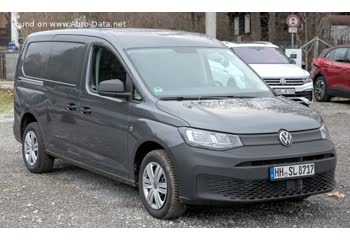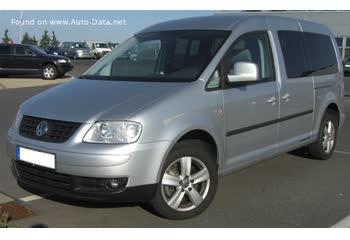Everything you need to know about specifications and performance - Volkswagen Caddy 2015 - 1.4 TGI (110 Hp) CNG DSG

Overview:
What is the engine capacity of a Volkswagen Caddy 2015?
The engine capacity of the Volkswagen Caddy 2015 is 1395.
Volkswagen Caddy 2015 How many horsepower?
The engine power of the Volkswagen Caddy 2015 is 110 Hp @ 4800-6000 rpm..
What is the Volkswagen Caddy 2015 engine?
Volkswagen Caddy 2015 engine is EA211 / CPWA. (Click to see other cars using the same engine)
How much gasoline does a Volkswagen Caddy 2015 consume?
The Volkswagen Caddy 2015 consumes 4.3-4.7 kg/100 km liters of gasoline per 100 km
General:
Brand: Volkswagen
Model: Caddy
Generation: IV
Modification (Engine): 1.4 TGI (110 Hp) CNG DSG
Start of production: 2015
End of production: 2020
Powertrain Architecture: Internal Combustion Engine
Body type:Mini van
Seats: 5-7
Doors: 4-5
Engine:
Engine systems: Start & Stop System
Power: 110 hp @ 4800-6000 rpm.
Power per litre: 78.9 hp/l
Torque: 200 nm @ 1500-3500 rpm.
Engine Model/Code:EA211 / CPWA
Engine displacement: 1395
Number of cylinders: 4
Engine configuration: Inline
Number of valves per cylinder: 4
Fuel injection system: Direct injection and Multi-port manifold injection
Engine aspiration: Turbocharger, Intercooler
Valvetrain: DOHC
Engine oil capacity: 4 l
Coolant: 5.6 l
Engine layout: Front, Transverse
Cylinder Bore: 74.5 mm
Piston Stroke: 80 mm
Compression ratio: 10.5:1
Performance:
Fuel Type: Petrol / CNG
Fuel consumption (economy) - urban: 5.3-5.7 kg/100 km
Fuel consumption (economy) - extra urban: 3.7-4.2 kg/100 km
Fuel consumption (economy) - urban (CNG): 5.3-5.7 kg/100 km
Fuel consumption (economy) - extra urban (CNG): 3.7-4.2 kg/100 km
Fuel consumption (economy) - combined (CNG): 4.3-4.7 kg/100 km
Fuel consumption (economy) - urban (CNG) (NEDC): 5.3-5.7 kg/100 km
Fuel consumption (economy) - extra urban (CNG) (NEDC): 3.7-4.2 kg/100 km
Fuel consumption (economy) - combined (CNG) (NEDC): 4.3-4.7 kg/100 km
Fuel consumption (economy) - combined: 4.3-4.7 kg/100 km
Emission standard: Euro 6
Acceleration 0 - 100 km/h: 12.9 sec
Acceleration 0 - 62 mph: 12.9 sec
Maximum speed: 172 km/h
Weight-to-power ratio: 13.6 kg/Hp, 73.3 Hp/tonne
Weight-to-torque ratio: 7.5 kg/Nm, 133.2 Nm/tonne
Acceleration 0 - 60 mph: 12.3 sec
Space:
Kerb Weight (kg): 1501-1521
Max. weight (kg): 2180
Max. roof load: 100 kg
Max load (kg): 659-679
Trunk (boot) space - maximum: 3200 l
Trunk (boot) space - minimum: 190 l
Permitted trailer load with brakes (12%): 1400 kg
Fuel tank capacity: 13 l
CNG cylinder capacity: 26 kg
Permitted trailer load without brakes: 750 kg
Permitted towbar download: 75 kg
dimensions:
Ramp-over (brakeover) angle: 13.2°
Length: 4408 mm
Width: 1793 mm
Height: 1858 mm
wheelbase: 2682 mm
Width including mirrors: 2079 mm
Front overhang: 879 mm
Rear overhang: 847 mm
Ride height (ground clearance): 123 mm
Minimum turning circle (turning diameter): 11.1 m
Approach angle: 15.7°
Departure angle: 17.5°
Powertrain, Suspension and Brakes:
Drivetrain Architecture: The Internal combustion Engine (ICE) drives the front wheels of the vehicle.
Drive wheel: Front wheel drive
Number of gears and type of gearbox: 6 gears, automatic transmission DSG
Front brakes: Ventilated discs, 288x25 mm
Rear brakes: Disc, 272x10 mm
Assisting systems: ABS (Anti-lock braking system)
Steering type: Steering rack and pinion
Power steering: Electric Steering
Tires size: 195/65 R15; 205/55 R16
Wheel rims size: 6J x 15; 6J x 16
Front suspension: Independent, type McPherson with coil Spring and anti-roll bar
Rear suspension: Rigid axle suspension, Transverse stabilizer, Leaf Spring
See also

Last generation.
Its production began in 2024 until Now

Other generation.
Its production began in 2009 until 2010

Write a comment